Charming Austrian actor Willi Forst (1903-1980) was a darling of the German-speaking public. He was also one of the most significant directors, producers, and writers of the Wiener Filme, the light Viennese musical comedies of the 1930s.
![Willi Forst]()
German postcard by Ross Verlag, no. 7050/2, 1932-1933. Photo: Ufa.
![Willi Forst]()
German postcard by Ross Verlag, no. 8478/2, 1933-1934. Photo: Boston-Film.
![Willi Forst]()
German postcard by Ross Verlag, no. A 1661/1, 1937-1938. Photo: Alex Binder, Berlin.
![Willi Forst]()
German postcard by Ross Verlag, no. A 3149/2, 1941-1944. Photo: Tobis.
![Willi Forst]()
German postcard by Ross Verlag, no. 519, 1941-1944. Photo: Atelier Balázs, Berlin.
Willi (also written as Willy) Forst was born as Wilhelm Anton Frohs in Vienna, Austria-Hungary (now Austria), in 1903.
At age 16, he began his career as an actor on the provincial stages in the Austria–Hungary and the German Empire, and appeared as a featured performer in the post World War I operetta theatres of Vienna and Berlin.
He also worked with famous directors like Erwin Piscator and Max Reinhardt. He made his film debut in the Austrian film Der Wegweiser/The Signpost (Hans Kottow, 1920).
His first major screen roles were opposite Marlene Dietrich in the silent films Café Elektric/Cafe Electric (Gustav Ucicky, 1927) and Gefahren der Brautzeit/Dangers of the Engagement Period (Fred Sauer, 1929).
![Willi Forst]()
German postcard by Ross Verlag, no. 5762/1, 1930-1931. Photo: Ufa.
![Willi Forst]()
German postcard by Ross Verlag, no. 5762/2, 1930-1931. Photo: Ufa.
![Willi Forst]()
German postcard by Ross Verlag, no. 6069/2 1931-1932. Photo: Atelier Binder, Berlin.
![Willi Forst]()
German postcard by Ross Verlag, no. 7050/3, 1932-1933. Photo: Ufa.
![Willi Forst]()
Greman postcard by Ross Verlag, no. 8257/1, 1933-1934. Photo: Ufa / Cine-Allianz.
Willi Forst made his sound and singing film debut in Atlantik/Titanic (Ewald André Dupont, 1929) and soon became known for his distinctive velvety voice and 'charming Viennese' characters.
After Zwei Herzen im 3/4 Takt/Two Hearts in Waltz Time (Géza von Bolváry, 1930), he played six more times under the direction of Géza von Bolváry.
Most of these successes were written by Walter Reisch, and so were also Ein blonder Traum/A Blonde's Dream (Paul Martin, 1932) with Lilian Harvey and Willy Fritsch, and Der Prinz von Arkadien/The Prince from Arcadien (Karl Hartl, 1932) with Liane Haid.
Forst considered the best learning experience for his future role as director, So ein Mädel vergisst man nicht/Unforgettable Girl (1933) directed by expressionist film actor-turned-director Fritz Kortner.
![Willi Forst in Ein blonder Traum (1932)]()
German postcard by Ross Verlag, no. 7032/1, 1932-1933. Photo: Ufa. Publicity still for Ein blonder Traum/Happy Ever After (Paul Martin, 1932).
![Willy Fritsch, Lilian Harvey, Willi Forst, Ein blonder Traum]()
German postcard by Ross Verlag, no. 143/4, 1931-1932. Photo: Ufa. Publicity still for Ein blonder Traum/Happy Ever After (Paul Martin, 1932).
![Liane Haid & Willi Forst]()
German postcard by Ross Verlag, no. 8258/1, 1933-1934. Photo: Ufa / Cine Allianz. Publicity still for the romantic comedy Ihre Durchlaucht, die Verkäuferin/Her Excellency, the Salesgirl (Karl Hartl, 1933) with Liane Haid.
![Magda Schneider and Willi Forst in Ich Kenn Dich Nicht Und Liebe Dich (1934)]()
British postcard. Photo: publicity still for Ich Kenn Dich Nicht Und Liebe Dich/I Don't Know You, But I Love You (Géza von Bolváry, 1934).
![Dolly Haas, Willi Forst, Oscar Sima]()
Dutch postcard by Filma, no. 449. Photo: Dolly Haas, Willi Forst and Oskar Sima in So ein Mädel vergisst man nicht (1932).
Willi Forst developed the genre of the Wiener Filme with writer Walter Reisch in the 1930s, beginning with the Franz Schubert melodrama Leise flehen meine Lieder/Lover Divine (Willi Forst, 1933).
He followed it with the hit Maskerade/Masquerade in Vienna (Willi Forst, 1934), which launched his fame as a significant director and made an instant star of Paula Wessely.
For Mazurka (Willi Forst, 1935), he lured Pola Negriback from Hollywood.
From the mid-1930s he also recorded many records, largely of sentimental Viennese songs, for the Odeon Recordslabel owned by Carl Lindström AG.
He founded his own film company, Willi Forst-Film, in 1937. His best known film would be the elegant satire Bel Ami (Willi Forst, 1939) based on the novel by Guy de Maupassant. He also played the title role, which would be his alter ego from then on.
![Willi Forst]()
Dutch Postcard by City Film, no. 151.
![Willi Forst]()
Dutch Postcard by JosPe, Arnhem, no. 429. Photo: Filma.
![Willi Forst]()
Dutch postcard by JosPe, Arnhem, no. 984. Photo: Remaco.
![Willi Forst]()
German postcard by Ross Verlag, no. 5700/1, 1930-1931. Photo: Super-Film.
![Willi Forst]()
German postcard by Ross Verlag, no. 7701/1, 1932-1933. Photo: Tonal - Universal. Publicity still for Brennendes Geheimnis/The Burning Secret (Robert Siodmak, 1933).
Following the annexation of Austria in 1938, Willi Forst was much courted by the Nazis. He succeeded in avoiding overt political statements, concentrating entirely on the light entertainment for which he was famous and which was much in demand during the war.
During the seven year period of National Socialist rulein Austria, he only made four films, none of them political. His most important work was his Wien-Film trilogy: Operette/Operetta (Willi Forst, 1940), Wiener Blut/Vienna Blood (Willi Forst, 1942), and Wiener Mädeln/Vienna Beauties (Willi Forst, begun in 1944, but not completed until 1949).
After the war he had comparatively little success, with the exception of the film Die Sünderin/The Sinner (Willi Forst, 1951) starring Hildegard Knef and Gustav Fröhlich. The frank treatment of social and sexual mores in Germany during and after the war ánd a modest nude scene of Knef created a furor at the release, but the film went on to attract an audience of seven million people.
Willi Forst's last film was the comedy Wien, du Stadt meiner Träume/Vienna, City of My Dreams (Willi Forst, 1957), with Adrian Hoven and Erika Remberg.
Then Willi Forst retired from the film world, acknowledging that his style was no longer in demand. After the death of his wife in 1973 he lived a reclusive life in the Swiss canton of Tessin. He died of cancer in Vienna in 1980 and is buried in Neustift am Walde.
At Senses of Cinema, professor Robert von Dassanowsky writes that Forst is "one of Austrian and Central European cinema's greatest filmmakers and influential industry figures, whose lack of presence in the international film 'canon' of important directors today is one more casualty from the negligence that has greeted Austrian cinema since the collapse of its commercial film industry in the 1960's."
![Willi Forst]()
Spanish collector's card by I.G. Viladot, Barcelona. Image: Cifesa.
![Willi Forst]()
Dutch postcard by JSA, no. 232. Photo: Freiherr Wolff von Gudenberg. [Baron] Wolff von Gudenberg (1890-1961) was a noted and fashionable photographer in the 1920s and 1930s.
![Willi Forst]()
French postcard by Europe, no. 989. Photo: Mercure Film.
![Willi Forst]()
French postcard by Europe, no. 1073. Photo: Mercure Film.
Sources: Robert von Dassanowsky (Senses of Cinema), Thomas Staedeli (Cyranos), Filmportal.de, Wikipedia and IMDb.

German postcard by Ross Verlag, no. 7050/2, 1932-1933. Photo: Ufa.

German postcard by Ross Verlag, no. 8478/2, 1933-1934. Photo: Boston-Film.

German postcard by Ross Verlag, no. A 1661/1, 1937-1938. Photo: Alex Binder, Berlin.

German postcard by Ross Verlag, no. A 3149/2, 1941-1944. Photo: Tobis.

German postcard by Ross Verlag, no. 519, 1941-1944. Photo: Atelier Balázs, Berlin.
Marlene Dietrich
Willi (also written as Willy) Forst was born as Wilhelm Anton Frohs in Vienna, Austria-Hungary (now Austria), in 1903.
At age 16, he began his career as an actor on the provincial stages in the Austria–Hungary and the German Empire, and appeared as a featured performer in the post World War I operetta theatres of Vienna and Berlin.
He also worked with famous directors like Erwin Piscator and Max Reinhardt. He made his film debut in the Austrian film Der Wegweiser/The Signpost (Hans Kottow, 1920).
His first major screen roles were opposite Marlene Dietrich in the silent films Café Elektric/Cafe Electric (Gustav Ucicky, 1927) and Gefahren der Brautzeit/Dangers of the Engagement Period (Fred Sauer, 1929).

German postcard by Ross Verlag, no. 5762/1, 1930-1931. Photo: Ufa.

German postcard by Ross Verlag, no. 5762/2, 1930-1931. Photo: Ufa.

German postcard by Ross Verlag, no. 6069/2 1931-1932. Photo: Atelier Binder, Berlin.
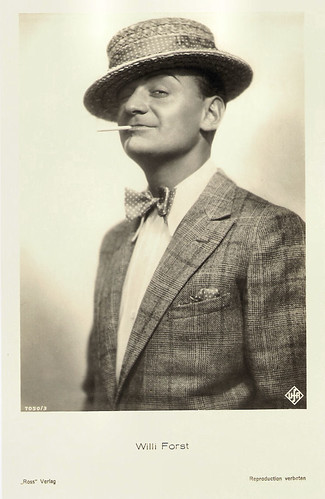
German postcard by Ross Verlag, no. 7050/3, 1932-1933. Photo: Ufa.
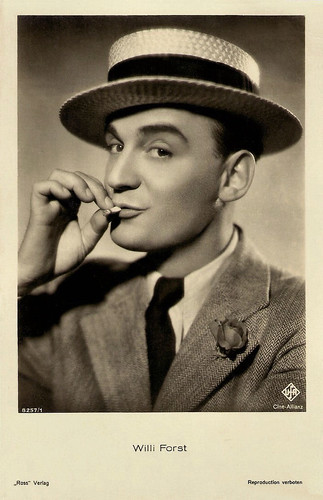
Greman postcard by Ross Verlag, no. 8257/1, 1933-1934. Photo: Ufa / Cine-Allianz.
Velvety Voice
Willi Forst made his sound and singing film debut in Atlantik/Titanic (Ewald André Dupont, 1929) and soon became known for his distinctive velvety voice and 'charming Viennese' characters.
After Zwei Herzen im 3/4 Takt/Two Hearts in Waltz Time (Géza von Bolváry, 1930), he played six more times under the direction of Géza von Bolváry.
Most of these successes were written by Walter Reisch, and so were also Ein blonder Traum/A Blonde's Dream (Paul Martin, 1932) with Lilian Harvey and Willy Fritsch, and Der Prinz von Arkadien/The Prince from Arcadien (Karl Hartl, 1932) with Liane Haid.
Forst considered the best learning experience for his future role as director, So ein Mädel vergisst man nicht/Unforgettable Girl (1933) directed by expressionist film actor-turned-director Fritz Kortner.

German postcard by Ross Verlag, no. 7032/1, 1932-1933. Photo: Ufa. Publicity still for Ein blonder Traum/Happy Ever After (Paul Martin, 1932).

German postcard by Ross Verlag, no. 143/4, 1931-1932. Photo: Ufa. Publicity still for Ein blonder Traum/Happy Ever After (Paul Martin, 1932).

German postcard by Ross Verlag, no. 8258/1, 1933-1934. Photo: Ufa / Cine Allianz. Publicity still for the romantic comedy Ihre Durchlaucht, die Verkäuferin/Her Excellency, the Salesgirl (Karl Hartl, 1933) with Liane Haid.
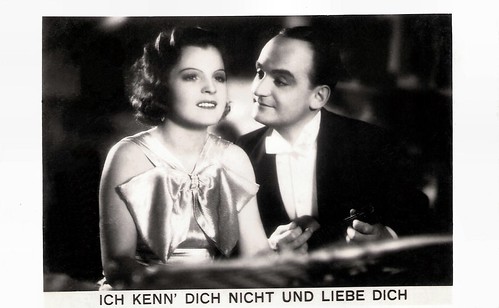
British postcard. Photo: publicity still for Ich Kenn Dich Nicht Und Liebe Dich/I Don't Know You, But I Love You (Géza von Bolváry, 1934).

Dutch postcard by Filma, no. 449. Photo: Dolly Haas, Willi Forst and Oskar Sima in So ein Mädel vergisst man nicht (1932).
Bel Ami
Willi Forst developed the genre of the Wiener Filme with writer Walter Reisch in the 1930s, beginning with the Franz Schubert melodrama Leise flehen meine Lieder/Lover Divine (Willi Forst, 1933).
He followed it with the hit Maskerade/Masquerade in Vienna (Willi Forst, 1934), which launched his fame as a significant director and made an instant star of Paula Wessely.
For Mazurka (Willi Forst, 1935), he lured Pola Negriback from Hollywood.
From the mid-1930s he also recorded many records, largely of sentimental Viennese songs, for the Odeon Recordslabel owned by Carl Lindström AG.
He founded his own film company, Willi Forst-Film, in 1937. His best known film would be the elegant satire Bel Ami (Willi Forst, 1939) based on the novel by Guy de Maupassant. He also played the title role, which would be his alter ego from then on.

Dutch Postcard by City Film, no. 151.
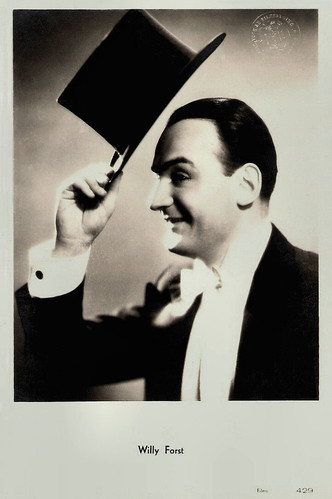
Dutch Postcard by JosPe, Arnhem, no. 429. Photo: Filma.

Dutch postcard by JosPe, Arnhem, no. 984. Photo: Remaco.
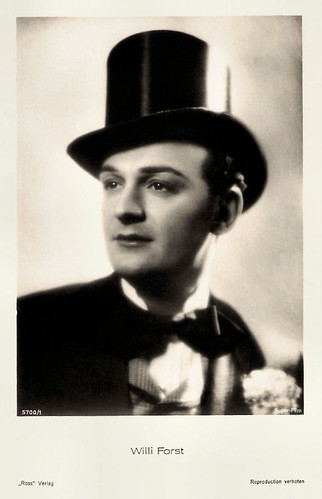
German postcard by Ross Verlag, no. 5700/1, 1930-1931. Photo: Super-Film.

German postcard by Ross Verlag, no. 7701/1, 1932-1933. Photo: Tonal - Universal. Publicity still for Brennendes Geheimnis/The Burning Secret (Robert Siodmak, 1933).
Wiener Filme
Following the annexation of Austria in 1938, Willi Forst was much courted by the Nazis. He succeeded in avoiding overt political statements, concentrating entirely on the light entertainment for which he was famous and which was much in demand during the war.
During the seven year period of National Socialist rulein Austria, he only made four films, none of them political. His most important work was his Wien-Film trilogy: Operette/Operetta (Willi Forst, 1940), Wiener Blut/Vienna Blood (Willi Forst, 1942), and Wiener Mädeln/Vienna Beauties (Willi Forst, begun in 1944, but not completed until 1949).
After the war he had comparatively little success, with the exception of the film Die Sünderin/The Sinner (Willi Forst, 1951) starring Hildegard Knef and Gustav Fröhlich. The frank treatment of social and sexual mores in Germany during and after the war ánd a modest nude scene of Knef created a furor at the release, but the film went on to attract an audience of seven million people.
Willi Forst's last film was the comedy Wien, du Stadt meiner Träume/Vienna, City of My Dreams (Willi Forst, 1957), with Adrian Hoven and Erika Remberg.
Then Willi Forst retired from the film world, acknowledging that his style was no longer in demand. After the death of his wife in 1973 he lived a reclusive life in the Swiss canton of Tessin. He died of cancer in Vienna in 1980 and is buried in Neustift am Walde.
At Senses of Cinema, professor Robert von Dassanowsky writes that Forst is "one of Austrian and Central European cinema's greatest filmmakers and influential industry figures, whose lack of presence in the international film 'canon' of important directors today is one more casualty from the negligence that has greeted Austrian cinema since the collapse of its commercial film industry in the 1960's."

Spanish collector's card by I.G. Viladot, Barcelona. Image: Cifesa.

Dutch postcard by JSA, no. 232. Photo: Freiherr Wolff von Gudenberg. [Baron] Wolff von Gudenberg (1890-1961) was a noted and fashionable photographer in the 1920s and 1930s.
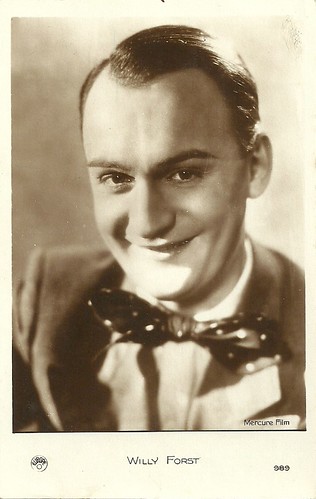
French postcard by Europe, no. 989. Photo: Mercure Film.
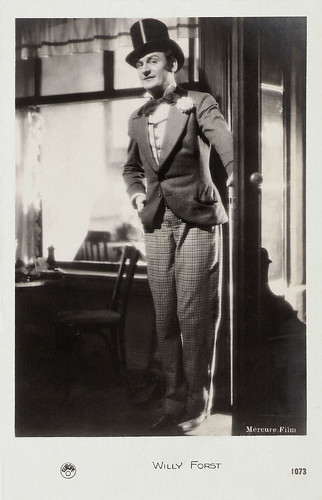
French postcard by Europe, no. 1073. Photo: Mercure Film.
Sources: Robert von Dassanowsky (Senses of Cinema), Thomas Staedeli (Cyranos), Filmportal.de, Wikipedia and IMDb.